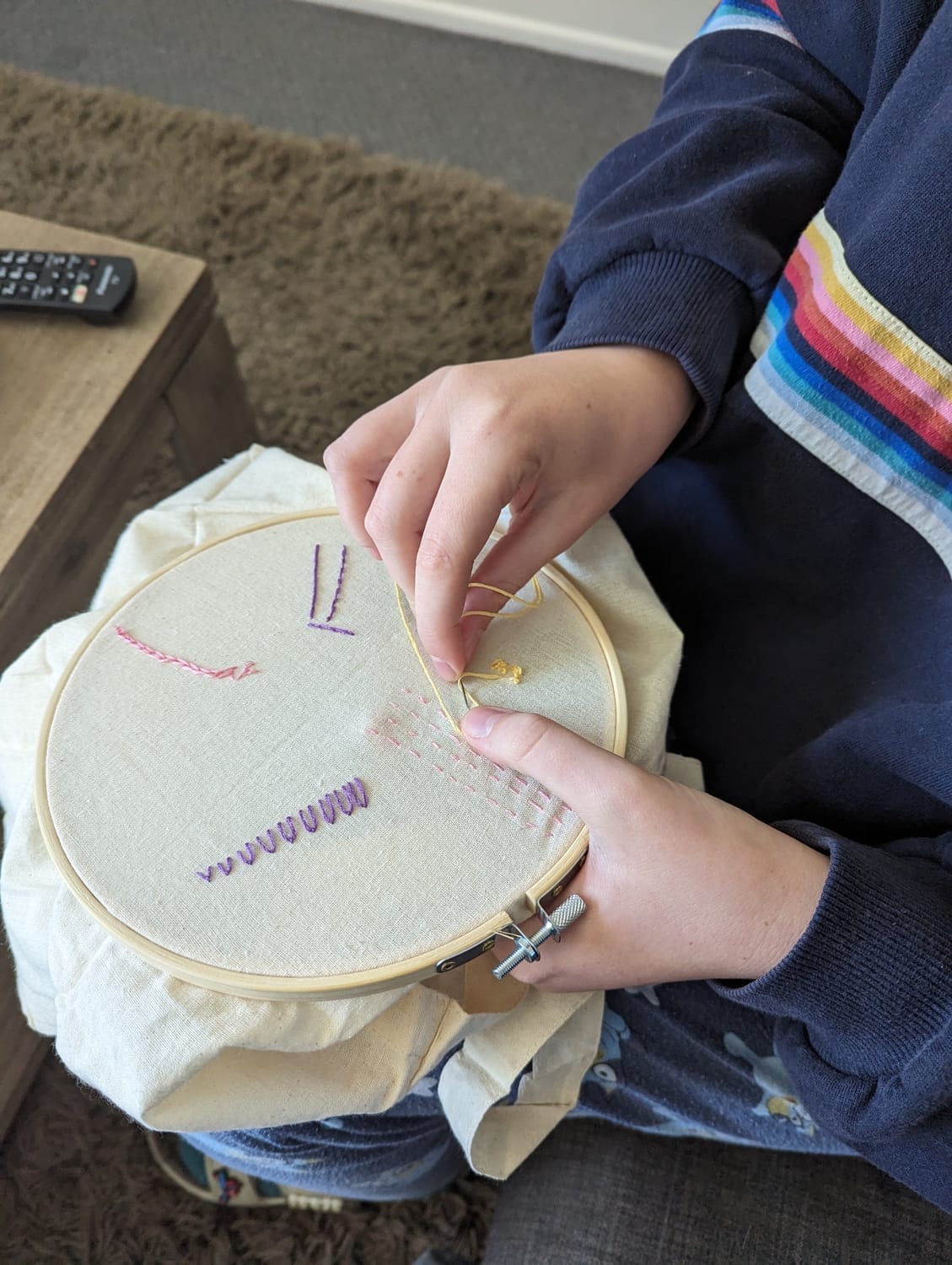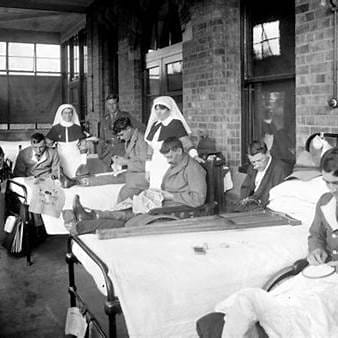
The Benefits of Embroidery for Mental Wellbeing
In today’s fast-paced world, we often find ourselves overwhelmed by stress, anxiety, and the constant pressure of everyday life. But what if picking up a needle and thread could be your 'self-care' ritual to reconnect to your creativity, release your emotions and relax your mind???
I have been embroidering for around 13 years and it has been my favourite tool to decompress and express myself. I don't know where I would be without stitching and I take it everywhere I go! Here is how stitching could help you too:
Benefits of Stitching:
Enhances Creativity & Intuition
Intuitive stitching, also known as slow stitching, encourages you to make creative decisions without a strict pattern.
This process helps you tap into your inner creativity and intuition, allowing for a more personal and expressive form of art¹.
Tool for relaxation & relieving stress
The repetitive and rhythmic nature of stitching can be very soothing. Studies have shown that engaging in repetitive tasks can help lower stress levels and promote relaxation².
Mindfulness Practice
Focusing on each stitch and the process of creating can bring you into the present moment, making it a great mindfulness practice. Mindfulness has been linked to reduced anxiety and improved emotional well-being¹.
Boosts self confidence
Completing a stitching project, no matter how small, can give you a sense of accomplishment and boost your self-confidence. This sense of achievement can be particularly beneficial for mental health².
Fine Motor Skills
The precise movements required in stitching can enhance your fine motor skills and hand-eye coordination. This can be especially beneficial for maintaining dexterity as you age².
Builds Patience
Stitching is a slow and deliberate process that requires patience. Over time, this practice can help you develop greater patience and perseverance².
Expression
Through intuitive stitching, you can express your thoughts, feelings, and creativity in a tangible form. This makes it a unique and personal form of expression¹.
Perfect Travel Companion
What I love about embroidery is the materials are small, minimal, lightweight and not messy which means you can easily pack them up in a pencil case and take them with you wherever you go! I don't travel anywhere without my stitching as it is my comfort mechanism. My stitching gives me a sense of home and familiarity so whenever I am feeling overwhelmed, anxious or need to do something with my hands I can always whip out my stitching. I also love that if you are feeling alone or scattered stitching can help you re-centre and feel comfortable in your own company.
It also blows me away the amount of strangers that will come up to you when you are stitching in public. Countless times I have been stitching at cafes and someone will come up to me and will feel comfortable about telling me how their 'grandma' does this and we go on sharing nostalgic feelings and stories of textiles. It has become a great coffee table ice breaker and a magnet for human connection!
Stitching is the perfect thing to do in transit especially when you have long bus/train or flights. It is also extra relaxing to take your stitching into nature and experience the tranquility of stitching as you are surrounded by the peace of nature. Nature also makes great inspiration for your creativity.
I love to go hiking or sit on the beach and stitch.
Connects you to your roots
Embroidery is an ancient craft which has been around for thousands of years. Humans have a sacred bond with the needle and thread however In our present society knowing how to simply stitch is something almost unheard of which bothers me as stitching is so deeply rooted in our blood and its magic is so powerful if only more people could feel it.
Cultures around the world have developed their own special techniques and methods of stitching which have intentionally been used to protect families from evil spirits and disease whilst also recording history, communicating and decorating.
When we see an embroidered tapestry or handkerchief we unknowingly feel a sense of nostalgia and comfort … this feeling is because of the magic and love behind the stitches and to understand it deeper we must try stitching ourselves. When you start stitching for the first time you will often feel this sense of ‘I’ve done this before’, just like weaving or knitting… that’s because its in our cellular memory passed down through generations upon generations.
Slows you down
In a fast-paced world, stitching can be a way to slow down and enjoy the process of creating something with your hands. This slower pace can help you appreciate the moment and reduce feelings of rush and overwhelm². It’s also a great way to get off technology and disconnect from all the ‘noise’.

Throughout history, stitching has been employed as a therapeutic tool across various cultures and contexts.
Here are some notable examples:

1. Occupational Therapy for World War I Soldiers
During World War I, injured soldiers were introduced to embroidery and other crafts as part of their rehabilitation. Engaging in these activities, often referred to as "fancy work," helped improve fine motor skills and provided psychological benefits. The repetitive nature of stitching offered a calming effect, aiding in the recovery from both physical and mental trauma. The Red Cross supplied templates for beginners, encouraging soldiers to embroider patriotic messages. Notably, 133 soldiers from different countries collaborated to create an altar cloth for St. Paul’s Cathedral.
Source: waldorfhandwork.org
2. Stitching in Psychiatric Institutions
In the 19th and early 20th centuries, psychiatric institutions recognized the therapeutic potential of needlework. Patients, particularly women, were encouraged to engage in sewing, weaving, knitting, and crochet. These activities provided a soothing and expressive outlet, fostering a sense of purpose and community among patients. The act of creating tangible items through stitching was believed to aid in mental health recovery.
Source: psychiatrictimes.com
3. Contemporary Trauma Therapy: Story Cloths
In modern times, the practice of creating story cloths has been integrated into art and narrative therapy. This approach allows individuals to externalize and process traumatic experiences by sewing their stories onto fabric. The tactile and non-threatening nature of fabric helps bring unspeakable experiences to light, facilitating healing and the emergence of alternative narratives. This method draws from cross-cultural traditions where sewing in community settings has been used to organize, build relationships, advocate, grieve, and heal.
Source: arttherapy.columbian.gwu.edu
4. Japanese Sashiko Stitching
In Japan, the traditional practice of Sashiko involves repetitive hand-stitching patterns, originally used to reinforce and repair clothing. Beyond its practical purposes, Sashiko has been recognized for its meditative qualities, with the rhythmic motion of stitching promoting mindfulness and tranquility.
Source: markandmovement.com.au
5. Lorina Bulwer's Embroidered Letters
Lorina Bulwer (c.1838-1912), a resident of the Great Yarmouth Workhouse in England, created extensive embroidered texts during her confinement. These textiles are believed to have served as a form of emotional expression and mental release, allowing her to process her thoughts and feelings through the act of stitching.
6. Moral Treatment in 19th Century Asylums
In the 19th century, the "Moral Treatment" approach in psychiatric care emphasized the therapeutic effects of engaging patients in productive activities. Institutions like the York Retreat in England incorporated sewing and embroidery into patient routines, believing that these activities could aid in mental recovery. Women, in particular, were often employed in sewing tasks, with their progress used as a measure of recovery.
7. Victorian “Sanity Stitching” (19th Century England & Europe)
In the 19th century, embroidery was often prescribed as a therapeutic activity for women dealing with stress, anxiety, or grief.
The repetitive nature of stitching was believed to calm the mind, leading to the term "sanity stitching."
Women created elaborate samplers, lacework, and tapestries, finding solace in the slow, rhythmic motion of embroidery.
Queen Victoria herself turned to embroidery after the death of Prince Albert, using it as a way to process grief.
Source: Women’s Work: The First 20,000 Years by Elizabeth Wayland Barber
8. Tatreez – Palestinian Embroidery for Reflection & Healing
Among Palestinian women, the tradition of Tatreez embroidery has long been a means of relaxation and self-expression. Women stitch intricate geometric and floral patterns onto their clothing and household textiles, often in communal settings that provide social bonding and emotional support. In modern times, Palestinian refugees have continued to use Tatreez as a way to cope with displacement and trauma, keeping their cultural identity alive through needle and thread. The slow, deliberate nature of this embroidery allows for reflection and healing.
Source: Tatreez & Tea – "The History of Palestinian Embroidery"
9. Indigenous Dream Stitching (North America & Australia)
Among Indigenous cultures in North America and Australia, embroidery and textile arts have been used for self-care and spiritual healing. Native American and Aboriginal Australian women often stitch symbols of protection, dreams, and personal prayers into their textiles, believing that the act of embroidery itself strengthens mental and emotional resilience. These stitched pieces often serve as talismans, connecting the maker to their ancestors and spiritual beliefs.
Source: Smithsonian National Museum of the American Indian
10. Kantha Embroidery – A Slow, Restorative Process (India & Bangladesh)
In India and Bangladesh, the tradition of Kantha embroidery has long been a form of self-care and relaxation. Women would repurpose old saris by stitching them together with intricate running stitches, creating soft, quilted textiles. The repetitive motion of stitching Kantha was seen as a meditative act, where each stitch carried personal prayers and blessings for loved ones. Even today, many artisans in Bengal continue this tradition, using embroidery as both a creative outlet and a method of mental relaxation.
Source: Kantha: The Embroidered Quilts of Bengal by P. Chishti & R. Wozniak, 2016
11. Medieval & Renaissance Embroidery – A Noblewoman’s Pastime (Europe)
During the medieval and Renaissance periods in Europe, embroidery was a noblewoman’s pastime, offering an escape from societal pressures. Women gathered in embroidery circles, stitching elaborate tapestries and religious garments while engaging in conversation, reflection, and storytelling. This communal practice fostered relaxation and emotional support, as well as a deep sense of purpose. Many of these embroidered pieces were devotional works, featuring prayers and biblical stories, reinforcing the spiritual and meditative aspects of stitching.
Source: Victoria & Albert Museum, London
How can you start stitching??
I believe intuitive stitching is the best way to introduce people to the world of embroidery. From my experience people can often feel overwhelmed by starting embroidery as it looks ‘hard’, ‘too intricate’, and people say they don’t have the ‘patience’ or ‘time’ for it.
This stigma makes me sad as it makes me realise that so many people will never get to experience how stitching can be a tool for relaxation and creativity.
I created the Intuitive Mindful Stitch Course as a gentle, creative way to help you slow down, reconnect, and experience the calming power of embroidery. It's the perfect starting point if you're new to stitching or just looking for a more mindful, meditative approach. No patterns, no pressure just pure creativity and all the amazing mental wellbeing benefits that come with it.
Click here to learn more about the course and start stitching today!
HEY, I’M DANI…
I am an embroidery artist & florist who is passionate about passing down the ancient wisdom of embroidery to help you connect with your roots, your creativity, your intuition, and all of the magic and healing benefits stitching brings.
I fell in love with embroidery at age 10 when my Nana first taught me some stitches. I haven't put the needle down since, it has helped me through all of my good and bad times and I honestly don't go anywhere without it.
I've always focused on embroidering clothing with intricate flower and nature designs but lately I've fallen deeply in love with the intuitive mindful style of stitching which I am really excited to teach people as it is so simple to learn!
Stay updated




